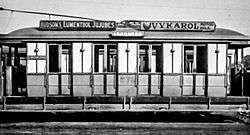Sydney J-Class Tram
| J-class | |
|---|---|
 | |
| Manufacturer |
Meadowbank Manufacturing Company E Chambers |
| Constructed | 1904-08 |
| Fleet numbers | 23, 25, 38, 39, 98, 101, 648-682, 741-745 |
| Specifications | |
| Train length | 29 ft 2 in (8.89 m) |
| Height | 12 ft 1.5 in (3.70 m) |
| Maximum speed | 60 km/h |
| Weight | 11.4 long tons (11.6 t) |
| Power output | 4 x 48 hp (later 60) |
| Electric system(s) | 600 V DC catenary |
| Current collection method | Pantograph |
| Track gauge | 1,435 mm (4 ft 8 1⁄2 in) |
The J-class trams were built as replacements for the King Street to Ocean Street, Edgecliff cable line designed to provide a frequent schedule, but with a lower seating capacity. Some briefly operated on the Manly lines in 1911. With the entry into service of the R class, withdrawals commenced in 1934 with all out of service by 1936.[1]
Preservation
One has been preserved:
- 675 at the Sydney Tramway Museum[2]
References
- ↑ MacCowan, Ian (1990). The Tramways of New South Wales. Oakleigh: Ian MacCowan. p. 121. ISBN 0 949600 25 3.
- ↑ "Sydney Tramway Museum Fleet Register" (PDF). Sydney Tramway Museum. Retrieved 4 September 2013.
Further reading
- Chinn, N (1975). New South Wales Tramcar Handbook 1861-1961. Vol. 1. South Pacific Electric Railway Cooperative Society. ISBN 9780959865967.
- McCarthy, Ken (1976). New South Wales Tramcar Handbook 1861-1961. Vol. 2. South Pacific Electric Railway Cooperative Society. ISBN 9780959865974.
External links
![]() Media related to Sydney J-Class Tram at Wikimedia Commons
Media related to Sydney J-Class Tram at Wikimedia Commons
This article is issued from Wikipedia - version of the 10/16/2016. The text is available under the Creative Commons Attribution/Share Alike but additional terms may apply for the media files.